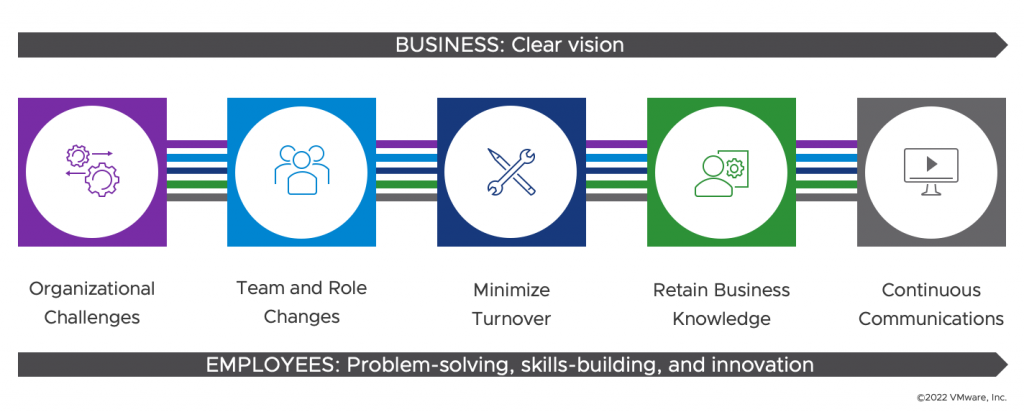This blog is part of a series about the operations pain points that many organizations face as they tackle digital transformation and change management. Our experts provide insights and recommendations based on their hands-on decades of experience and tackle some of the most pressing business and technology pain points.
It can be difficult to have a complete understanding of most operations problems from the outside looking in, but we’re in luck: our expert for this part of our pain points series has 45 years of tech experience. Norman Dee—rare in both depth of knowledge and experience—began his career as a mainframe systems programmer and is currently a Staff Architect at VMware for digital and cloud transformations.
Among his experience, Norman has generated systems, configured networks and databases, administered security, and specialized in capacity planning and usage accounting. He currently works on projects for multi-cloud application environments and the digital workforce.
A short history of how IT got here
In the not-too-distant past, IT was centralized and mainframes were king. A major shift to distributed technologies and IT management allowed business units to take ownership of their own IT and build out their own developer organizations, bringing about the role of the divisional Chief Information Officer (CIO). IT became the infrastructure provider for this distributed model.
Virtualized servers started replacing physical ones, then virtualized servers shifted to hyperconverged systems where network and storage are fully integrated.
“Mainframes didn’t roll over and play dead. They are still out there and have matured. I was at one customer site where they had three mainframes in one large rack—the same footprint as some hyperconverged systems. Everything has come full circle except for the management of IT,” says Norman.
Today, the migration to the cloud includes offloading IT’s infrastructure into a vendor-managed environment where companies can get the same services without having to own the entirety of the operations. The shift to vendor-managed environments has allowed for scale and automation, with vendors implementing efficient, unique hypervisors of their own for profit.
Shadow IT
As business units rely more and more on vendor-managed environments, a funny thing happens: they bypass the organization’s IT group. The distributed model that many organizations still foster has resulted in business units paying a premium to outside vendors for technology control—shadow IT—resulting in four key facts:
- Many organizations don’t fully know what they spend on IT because of vendor-managed environments throughout different business units paid out of different budgets
- Internal IT is challenged with competition from outside vendors to be business-aligned and responsive to business requests and concerns
- Internal IT is unable to fully vet and secure new technology purchases deploying around the organization
- Great redundancy of products and solutions exist in many organizations
What this means for people: Q&A

The following are Norman’s answers to some of the most common pain points around people in today’s vendor-managed and shadow IT environments.
What can IT groups learn from the distributed IT model?
IT organizations can align more to the business needs and mission and be less driven by technology itself.
What’s a common organizational challenge?
Many organizations have a large middle management layer that is filled with managers who are removed from technology and depend on pre-digested data. When this happens, executive management doesn’t get an accurate handle on how money is being spent, how effective IT is, what utilization is and should be, and what or how to remediate anything that’s not working for decision making.
How can the financial decision-makers ensure that they are receiving the right information to make those decisions? Who should they be talking to? What should they know?
Financial decision makers should regularly discuss needs directly with the IT group and ensure that they budget for organic growth, business requests from different business units, and new business requests. Once a budget forecast is negotiated and submitted, financial decision-makers must ensure that the budget is not cut in the final purchasing steps because of a lack of communication to purchasing areas.
Digital and operations transformations may result in organization and role changes for some staff. What’s the best way to manage this type of change in order to minimize turnover?
First, we make sure that any changes are driven by service to the overall business. While it’s tempting to rush assignments to a new operating model, I’ll share an example that illustrates how taking the time to do this well results in not only keeping employees, but empowering them to do what’s best for the business.
In this example, an extensive transformation included automation, hyperconvergence, and cloud management. Many older roles would no longer be needed, but there was also a great need to fill many new roles. The Human Resources department took an approach which allowed for the staff to get descriptions of new roles and a list of the roles that would be phased out, let them decide on what roles they wanted, and gave them time to gain the new skills required to fill those new roles. This approach resulted in a tremendous retention of business knowledge and relationships. Our step-by-step approach to human change management was documented in an earlier blog.
Digital transformations may cause change over several months and can be unnerving for employees. What can companies to minimize employee stress and maximize employee productivity during this period?
In a nutshell, it’s all about communication. But this communication must move in multiple directions: communications from and to executives, change teams, and line workers are essential to maintain support for the transformation and to continuously assure all employees of their importance to the business mission. Budget should be reserved for continuing education, training, and retention bonuses. Question-and-answer sessions as well as updated FAQs, accessible to all, are great tools for large-scale change and help maintain as much transparency as possible about how transformation projects are progressing and what effects they have on staff.
Let’s say you’re an employee without financial decision-making responsibility. How should you go about reporting issues and possible solutions?
Employees can prepare a simple business case that includes cost savings, speed to market, competitive edges, customer satisfaction, and employee satisfaction. Justifying a change wholistically, in business terms, will resonate with executives that are running the business.
What should organizations do to create an environment of transparency and safety for speaking out if someone sees ways to improve operations?
Healthy companies love and inspire field-driven innovation. An award program for employees who find ways to automate and improve operations is one tool to encourage this. One example of this is a utility company who required an extensive amount of detailed paper billing to their customers. Employees developed ways to automate the process and save many hours of churn and labor. The company invested in the suggested solution and employees were rewarded.
Some companies never seem to reach the point of completing a digital transformation and are consistently in a state of flux and change. What is your advice to those in this situation?
In reality, we are always changing and evolving. Is anything ever really complete? However, there are certain organizations that are not changing to evolve, but are constantly changing due to a lack of vision. Executives should be able to clearly articulate their vision and transformation phases. When that happens, there is always progress and consistency.
The biggest take-away
If you only remember one thing from this post, it should be this: transformations are about the business. If all your people and technology decisions serve the best interests of the business, your operations transformation will stay on track for success.
For more about change management, read, “10 Steps to Plan for Human Change Management.”




